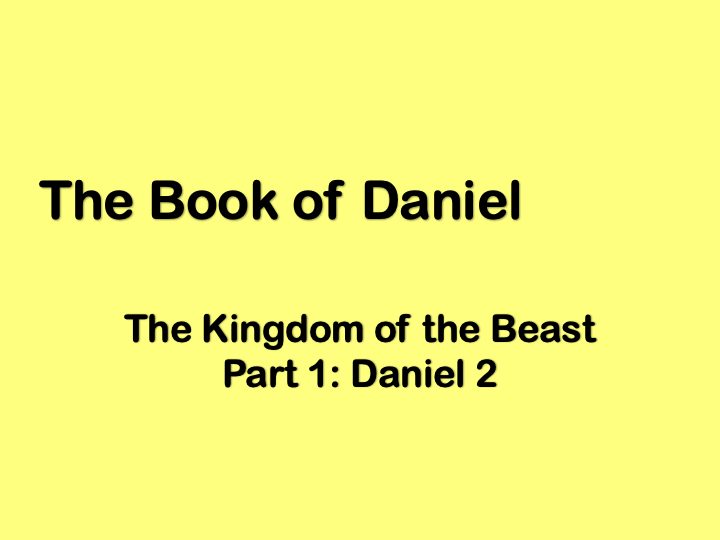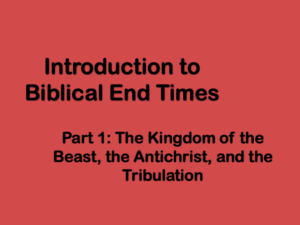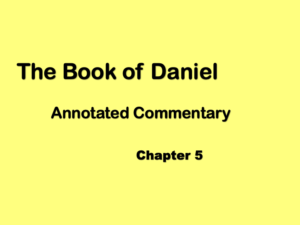What is The One World Order?
Two important end-times topics are introduced in the second chapter of Daniel. One is the One World Order, which we will discuss in the post, and the second is the Kingdom of God which we discuss in a subsequent post.

Part 1: Daniel Chapter 2
The One World Order is a common term used for a globalist, authoritarian government that will arise in the end times. Some may be surprised to learn that the One World Order has its origins in Biblical prophecy. It is described in Daniel and Revelation but is first mentioned in the second chapter of Daniel. When talking Biblical property, the One World Order is often called the Kingdom of the Beast
Nebuchadnezzar’s Dream: The First Three Kingdoms
In chapter 2, Nebuchadnezzar, the king of Babylon, has a prophetic dream. The king dreams of a statue composed of successive layers of material. It starts with a head of gold, but each descending portion is made of a different material. While the king watches, the statue is destroyed by a stone. The dream, as interpreted by Daniel, reveals a sequence of kingdoms that will follow Babylon. Daniel tells the king the golden head is the Neo-Babylonian Empire, represented by Nebuchadnezzar. After Nebuchadnezzar, Babylon would be replaced by a succession of three kingdoms, represented by the silver, brass and iron layers.
Historically, we know the Neo-Babylonian kingdom was replaced by the united kingdom of the Medes and the Persians, represented by the breast and arms of silver. The Persian Empire in turn was replaced by the Greeks, represented by the abdomen and thighs of brass. The identities of the second and third kingdoms, Persia and Greece, are confirmed later in Daniel.
The Fourth Kingdom
After the brass, however, the statue gets a little strange. First, the legs are made of iron, which is straight forward, and seems to represent the Roman Empire, but the feet are made from iron mixed with clay.
When Daniel gives the explanation of the fourth kingdom, it gets even stranger.
The fourth kingdom will be strong as iron, because iron breaks in pieces and subdues all things; and as iron that crushes all these, it will break in pieces and crush. Whereas you saw the feet and toes, part of potters’ clay, and part of iron, it will be a divided kingdom; but there will be in it of the strength of iron, because you saw the iron mixed with miry clay. As the toes of the feet were part of iron, and part of clay, so the kingdom will be partly strong, and partly broken. Whereas you saw the iron mixed with miry clay, they will mingle themselves with the seed of men; but they won’t cling to one another, even as iron does not mix with clay. (Daniel 2: 40-43)
On a superficial level, the verses appear to refer to the Roman Empire. Babylon was conquered by Cyrus the Great in 539 BC. The Persian Empire then ruled Babylon until 330 BC, when it was conquered by Alexander the Great, a Macedonian. After the death of Alexander in 323 BC, his vast empire splintered, and war broke out amongst Alexander’s surviving generals. Eventually, four successors emerged and established their own kingdoms. Notable among the successors were the Ptolemies who ruled Egypt and the Seleucids who ruled Syria. The Seleucid kingdom was conquered by Rome in 64 BC and Egypt was conquered in 30 BC
The fourth kingdom is characterized as “strong as iron” and the kingdom “as iron that crushes these, it will break and crush.” This language evokes the image of a violent kingdom that destroys its opponents. Rome could certainly be characterized as meeting these requirements. It was strong enough to dominate the Mediterranean and it did conquer and destroy a series of strong opponents. Some of the details of the fourth kingdom given in Nebuchadnezzar’s dream, however, do not match the historical Rome.
First, the is no clear historical precedent for Rome being a mixture of two powers, one strong (iron) and one brittle (clay). The imagery seems to suggest an uneasy alliance of two major powers, yet Rome had no history of allying with an equal power. Rome did eventually divide into two empires, Rome in the west and Byzantine in the east, but not in the way described in Daniel.
Secondly, there is the strange statement of “they will mingle themselves with the seed of men.” In the Bible, the “seed of men” refers to offspring, or genetic material. Historically, it is difficult to explain this statement in regards to Rome.
Whereas you saw the feet and toes, part of potters’ clay, and part of iron, it will be a divided kingdom; but there will be in it of the strength of iron, because you saw the iron mixed with miry clay.
Daniel 2: 41
Rome did become a divided kingdom in 285 AD when the Emperor Diocletian divided the empire into an western half, with the capital in Rome, and an eastern half with the capital in Constantinople. Rome fell in 476 AD when the Germanic king Odoacer deposed the last Roman emperor. The eastern half, which became the Byzantine Empire, lasted until 1453 AD when the Ottoman Empire captured Constantinople.
Rome but not Rome?
If the mixture of clay and iron is represented by the two halves of the Roman Empire, which half is the strong iron? An argument could be made that either half was the strong, the Roman Empire because it conquered most of the Mediterranean before it was divided, or the Byzantine Empire, because it outlasted the Roman Empire.
As the toes of the feet were part of iron, and part of clay, so the kingdom will be partly strong, and partly broken.
Daniel 2: 42
Again, which part was broken? Was it the Roman Empire because it fractured into various nations states? The language also suggests the two halves, the strong and the weak, will coexist at the same time.
Whereas you saw the iron mixed with miry clay, they will mingle themselves with the seed of men; but they won’t cling to one another, even as iron does not mix with clay.
Daniel 2: 43
Here the text gets very strange. First, who does the pronoun “they” refer to? Is it the Roman Empire? Is it the Byzantine Empire? Is it some other, unidentified entity? Secondly, how will “they” mix with the seed of men? In the Bible, the seed of men refers to either specifically the genetic material of men, sperm, or the offspring of men, depending on the context. In verse 43, it appears to refer to the offspring of men. If “they” mingle with the offspring of men, are they not human?
Perhaps a clue is the fact the legs of the statue are made of iron, but its feet are part iron and part clay. One interpretation is the legs of iron are the Roman Empire, but the feet of iron and clay are another kingdom that followed the Roman Empire.
Preterism vs Futurism
These problems in the interpretation of Daniel Chapter two, and other aspects of eschatology, have given rise to two competing schools of Biblical interpretation. Preterism proposes that all prophecy was fulfilled by the Roman Empire, culminating in the destruction of Jerusalem by Titus Vespianus in 70 AD. For modern Christian churches that do address eschatology, preterism is probably the majority view, especially among the larger denominations.
Futurism proposes that some prophecy was fulfilled by Rome, many prophecies will be fulfilled in the future by another kingdom with lings to Rome. This future kingdom is the Fourth Kingdom, sometimes called the Kingdom of the Beast because of later imagery in Daniel and Revelation, but it has also been called the One World Order. Futurism is a popular view among evangelical Christian traditions.
The verse, “They will mix themselves with the seed of men,” is a difficult passage for both schools of interpretation. Like many other specific prophecies, preterism tends to allegorize the verse. Proposed interpretations have been the mixing of the Roman Empire and the subjugated nations or the mixing of the ruling class and common folk of Rome.
Some proponents of futurism also take the allegory route and propose similar interpretations to preterist interpretation. A more modern interpretation is the verse is a reference to transhumanism, a current movement in science that seeks to improve humans through genetic engineering or by merge them with computer technology. The company Neurolink, which seeks to implant computer chips in human brains, is an example of Transhumanism.
However, a minority proposal is the verse is a reference to Genesis 6: 1-4, which tells the strange tale of the Nephilim, the offspring of angels and human women. We’ll discuss the topic more in a future blog post.
More About the Kingdom of the Beast in the Bible
Daniel returns to the topic of the One World Order in Chapter 7, where Daniel describe a vision of four animals, or beasts, rising from the sea. Like the statue in chapter 2, these beast represents future kingdoms and rulers. In Revelation, we learn the One World Order is associated with the Antichrist, who is also known as the Beast. The topic of the One World Order, as well as different interpretations, will be a major point of discussion as we progress through this study.




